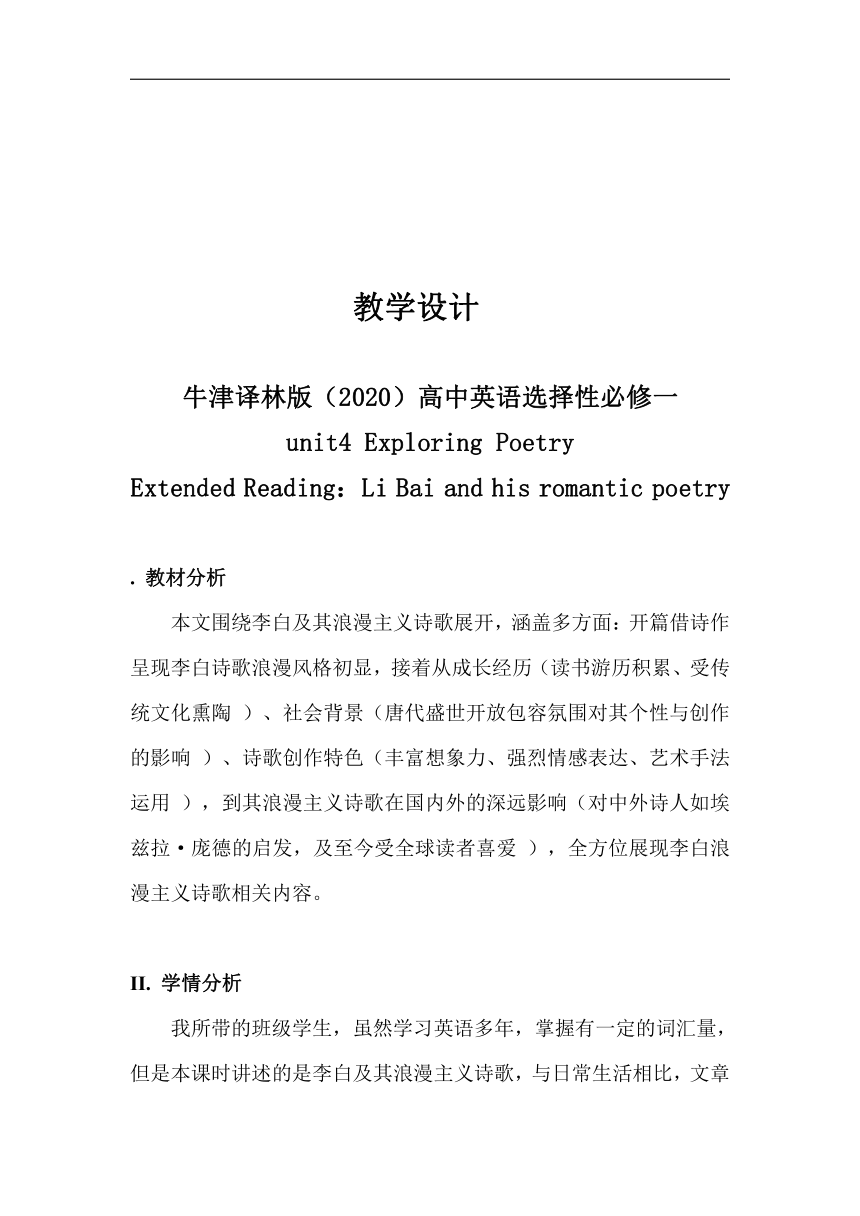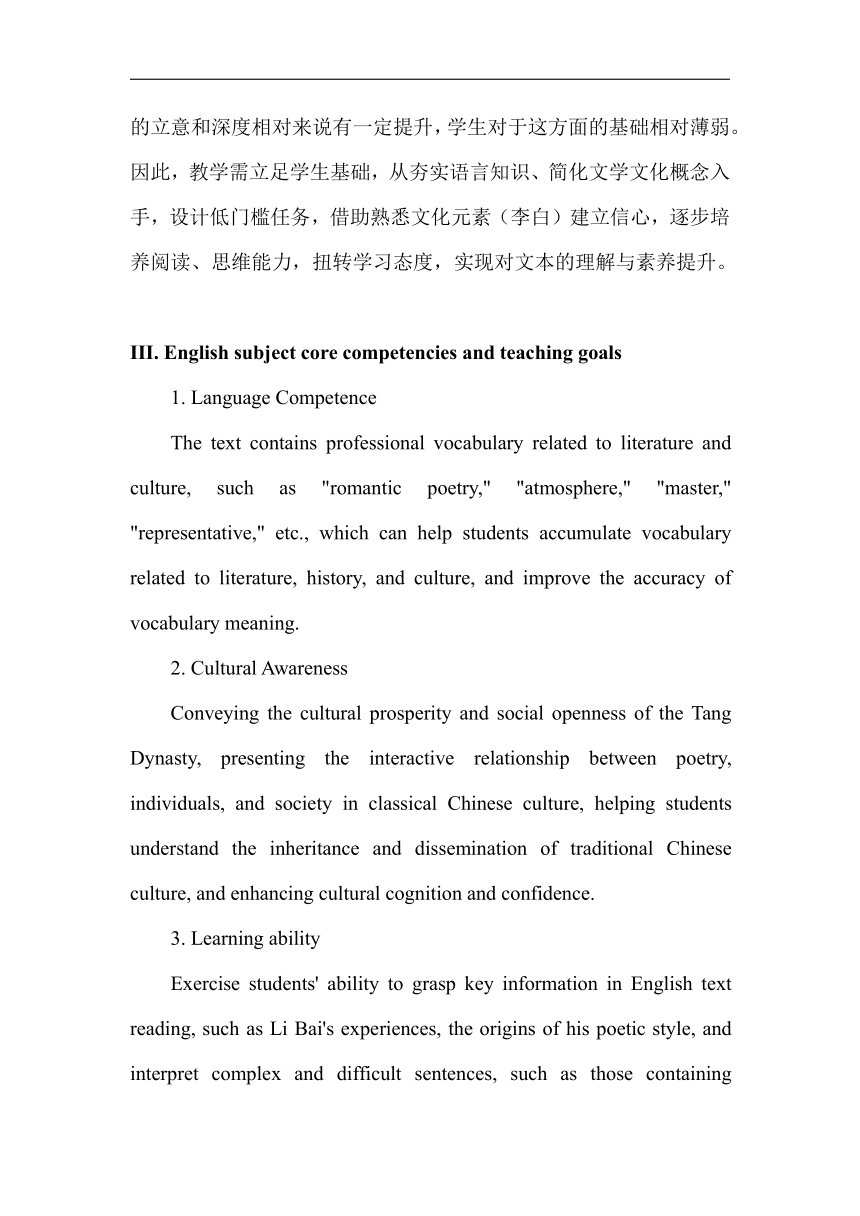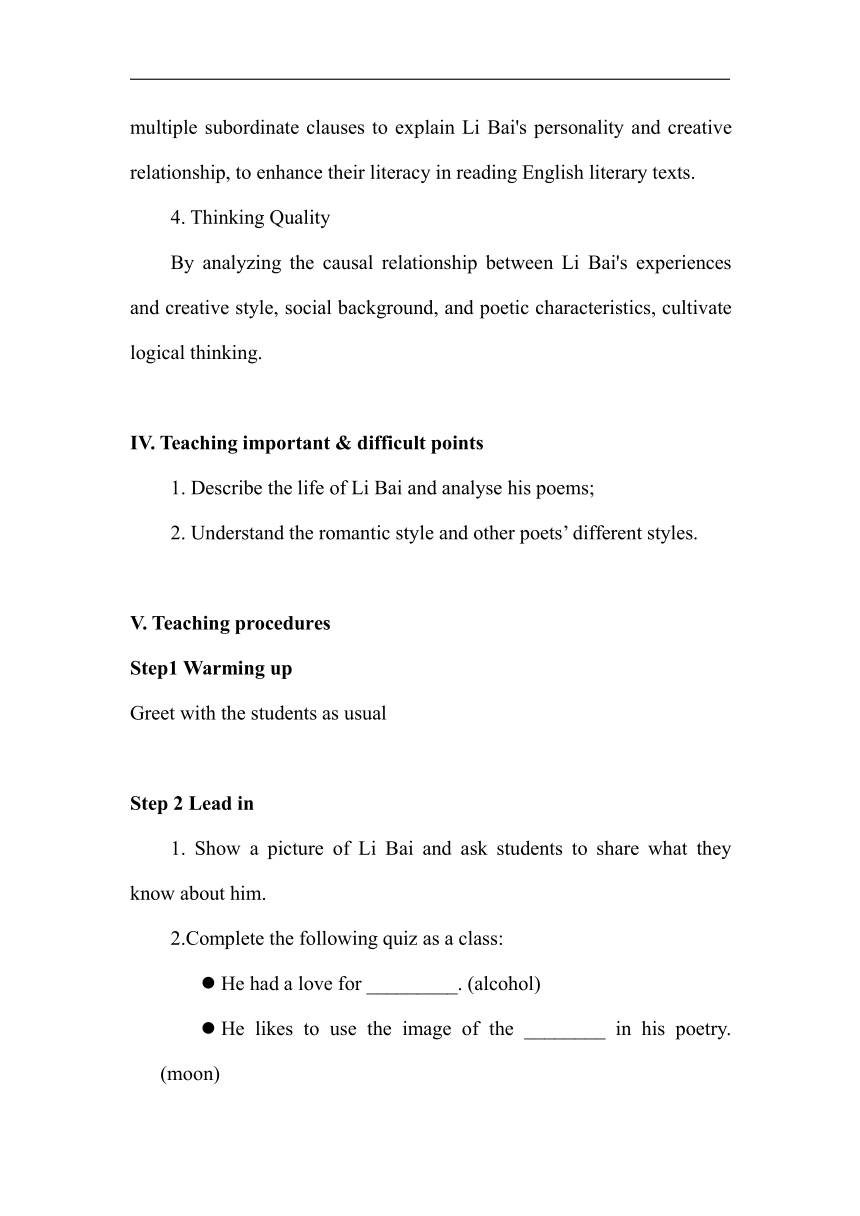Unit 4 Exploring Poetry Extended reading教学设计-2024-2025学年高中英语译林版(2019)选择性必修第一册
文档属性
| 名称 | Unit 4 Exploring Poetry Extended reading教学设计-2024-2025学年高中英语译林版(2019)选择性必修第一册 |  | |
| 格式 | docx | ||
| 文件大小 | 22.1KB | ||
| 资源类型 | 教案 | ||
| 版本资源 | 牛津译林版(2019) | ||
| 科目 | 英语 | ||
| 更新时间 | 2025-06-23 12:35:45 | ||
图片预览



文档简介
教学设计
牛津译林版(2020)高中英语选择性必修一
unit4 Exploring Poetry
Extended Reading:Li Bai and his romantic poetry
. 教材分析
本文围绕李白及其浪漫主义诗歌展开,涵盖多方面:开篇借诗作呈现李白诗歌浪漫风格初显,接着从成长经历(读书游历积累、受传统文化熏陶 )、社会背景(唐代盛世开放包容氛围对其个性与创作的影响 )、诗歌创作特色(丰富想象力、强烈情感表达、艺术手法运用 ),到其浪漫主义诗歌在国内外的深远影响(对中外诗人如埃兹拉·庞德的启发,及至今受全球读者喜爱 ),全方位展现李白浪漫主义诗歌相关内容。
II. 学情分析
我所带的班级学生,虽然学习英语多年,掌握有一定的词汇量,但是本课时讲述的是李白及其浪漫主义诗歌,与日常生活相比,文章的立意和深度相对来说有一定提升,学生对于这方面的基础相对薄弱。因此,教学需立足学生基础,从夯实语言知识、简化文学文化概念入手,设计低门槛任务,借助熟悉文化元素(李白)建立信心,逐步培养阅读、思维能力,扭转学习态度,实现对文本的理解与素养提升。
III. English subject core competencies and teaching goals
1. Language Competence
The text contains professional vocabulary related to literature and culture, such as "romantic poetry," "atmosphere," "master," "representative," etc., which can help students accumulate vocabulary related to literature, history, and culture, and improve the accuracy of vocabulary meaning.
2. Cultural Awareness
Conveying the cultural prosperity and social openness of the Tang Dynasty, presenting the interactive relationship between poetry, individuals, and society in classical Chinese culture, helping students understand the inheritance and dissemination of traditional Chinese culture, and enhancing cultural cognition and confidence.
3. Learning ability
Exercise students' ability to grasp key information in English text reading, such as Li Bai's experiences, the origins of his poetic style, and interpret complex and difficult sentences, such as those containing multiple subordinate clauses to explain Li Bai's personality and creative relationship, to enhance their literacy in reading English literary texts.
4. Thinking Quality
By analyzing the causal relationship between Li Bai's experiences and creative style, social background, and poetic characteristics, cultivate logical thinking.
IV. Teaching important & difficult points
1. Describe the life of Li Bai and analyse his poems;
2. Understand the romantic style and other poets’ different styles.
V. Teaching procedures
Step1 Warming up
Greet with the students as usual
Step 2 Lead in
1. Show a picture of Li Bai and ask students to share what they know about him.
2.Complete the following quiz as a class:
He had a love for _________. (alcohol)
He likes to use the image of the ________ in his poetry. (moon)
He lived in the ________ period of the Tang Dynasty. (most glorious)
People call him _______________. (Fairy Poet)
3.Introduce the learning objectives for the lesson.
Step 3 Fast-reading
1.Instruct students to read the passage quickly and find the topic sentence of each paragraph.
2.Guide students to identify the text structure using the following framework:
Introduction (Para. 1): A sign of Li Bai's romantic style shown in A Night Stay at a Mountain Temple.
Reasons (Paras. 2-4): Factors contributing to his romantic style (personal experiences and social context).
Features (Para. 5): Artistic characteristics of his poetry.
Influence (Para. 6): Li Bai's status and global impact.
Check answers and clarify any confusion.
Step 4 Careful Reading
Paragraph 1
1.Present the poem A Night Stay at a Mountain Temple:
2.Ask students: "How does this poem display Li Bai's style "
3.Highlight the use of exaggeration ("a hundred feet", "scaring dwellers on high") as a typical romantic technique.
Paragraphs 2-4
1.Group Activity: Divide students into groups to complete the following table:
Factors Details
Love of Reading - 5 years old: Started studying the classics.
- 10 years old: Read ancient philosophers of different schools (Confucianism, Taoism).
- Read books from legends to historical stories.
Love of Travelling - Early twenties: Left home to travel around.
- Visited famous mountains, great rivers, and encountered diverse customs.
- Nourished love of nature and gained writing inspiration.
Social-Historical Context - Lived in the most glorious period of the Tang Dynasty.
- Economic boom and open-tolerant society.
Each group presents their findings, and the teacher summarizes the contributions of these factors to Li Bai's romantic style.
Paragraph 5
1.Discuss the features of Li Bai's romantic poetry:
Rich imagination (using moon, stars, legends as vehicles).
Free expression of strong feelings (breathing vitality into lifeless objects).
Artistic techniques (exaggeration, metaphor, personification).
2.Relate these features to the poem Leaving the White Emperor Town at Dawn.
Paragraph 6
1.Introduce Li Bai's international impact with the example of Ezra Pound:
Ezra Pound (1885–1972), an American poet, translated Li Bai's poems in his collection Cathay (1915).
2.Discuss: "Why is Ezra Pound's example used here What does it show about Li Bai's influence "
3.Conclude that Li Bai's poetry transcends time and space, inspiring global readers.
Step 5 Summary and Homework Summary
Recap Li Bai's life, the reasons for his romantic style, its features, and his influence.
Homework:
Write a summary (150-200 words) about Li Bai's life and poetry, including:
His key life experiences.
Main characteristics of his romantic poetry.
His significance in Chinese and world literature.
牛津译林版(2020)高中英语选择性必修一
unit4 Exploring Poetry
Extended Reading:Li Bai and his romantic poetry
. 教材分析
本文围绕李白及其浪漫主义诗歌展开,涵盖多方面:开篇借诗作呈现李白诗歌浪漫风格初显,接着从成长经历(读书游历积累、受传统文化熏陶 )、社会背景(唐代盛世开放包容氛围对其个性与创作的影响 )、诗歌创作特色(丰富想象力、强烈情感表达、艺术手法运用 ),到其浪漫主义诗歌在国内外的深远影响(对中外诗人如埃兹拉·庞德的启发,及至今受全球读者喜爱 ),全方位展现李白浪漫主义诗歌相关内容。
II. 学情分析
我所带的班级学生,虽然学习英语多年,掌握有一定的词汇量,但是本课时讲述的是李白及其浪漫主义诗歌,与日常生活相比,文章的立意和深度相对来说有一定提升,学生对于这方面的基础相对薄弱。因此,教学需立足学生基础,从夯实语言知识、简化文学文化概念入手,设计低门槛任务,借助熟悉文化元素(李白)建立信心,逐步培养阅读、思维能力,扭转学习态度,实现对文本的理解与素养提升。
III. English subject core competencies and teaching goals
1. Language Competence
The text contains professional vocabulary related to literature and culture, such as "romantic poetry," "atmosphere," "master," "representative," etc., which can help students accumulate vocabulary related to literature, history, and culture, and improve the accuracy of vocabulary meaning.
2. Cultural Awareness
Conveying the cultural prosperity and social openness of the Tang Dynasty, presenting the interactive relationship between poetry, individuals, and society in classical Chinese culture, helping students understand the inheritance and dissemination of traditional Chinese culture, and enhancing cultural cognition and confidence.
3. Learning ability
Exercise students' ability to grasp key information in English text reading, such as Li Bai's experiences, the origins of his poetic style, and interpret complex and difficult sentences, such as those containing multiple subordinate clauses to explain Li Bai's personality and creative relationship, to enhance their literacy in reading English literary texts.
4. Thinking Quality
By analyzing the causal relationship between Li Bai's experiences and creative style, social background, and poetic characteristics, cultivate logical thinking.
IV. Teaching important & difficult points
1. Describe the life of Li Bai and analyse his poems;
2. Understand the romantic style and other poets’ different styles.
V. Teaching procedures
Step1 Warming up
Greet with the students as usual
Step 2 Lead in
1. Show a picture of Li Bai and ask students to share what they know about him.
2.Complete the following quiz as a class:
He had a love for _________. (alcohol)
He likes to use the image of the ________ in his poetry. (moon)
He lived in the ________ period of the Tang Dynasty. (most glorious)
People call him _______________. (Fairy Poet)
3.Introduce the learning objectives for the lesson.
Step 3 Fast-reading
1.Instruct students to read the passage quickly and find the topic sentence of each paragraph.
2.Guide students to identify the text structure using the following framework:
Introduction (Para. 1): A sign of Li Bai's romantic style shown in A Night Stay at a Mountain Temple.
Reasons (Paras. 2-4): Factors contributing to his romantic style (personal experiences and social context).
Features (Para. 5): Artistic characteristics of his poetry.
Influence (Para. 6): Li Bai's status and global impact.
Check answers and clarify any confusion.
Step 4 Careful Reading
Paragraph 1
1.Present the poem A Night Stay at a Mountain Temple:
2.Ask students: "How does this poem display Li Bai's style "
3.Highlight the use of exaggeration ("a hundred feet", "scaring dwellers on high") as a typical romantic technique.
Paragraphs 2-4
1.Group Activity: Divide students into groups to complete the following table:
Factors Details
Love of Reading - 5 years old: Started studying the classics.
- 10 years old: Read ancient philosophers of different schools (Confucianism, Taoism).
- Read books from legends to historical stories.
Love of Travelling - Early twenties: Left home to travel around.
- Visited famous mountains, great rivers, and encountered diverse customs.
- Nourished love of nature and gained writing inspiration.
Social-Historical Context - Lived in the most glorious period of the Tang Dynasty.
- Economic boom and open-tolerant society.
Each group presents their findings, and the teacher summarizes the contributions of these factors to Li Bai's romantic style.
Paragraph 5
1.Discuss the features of Li Bai's romantic poetry:
Rich imagination (using moon, stars, legends as vehicles).
Free expression of strong feelings (breathing vitality into lifeless objects).
Artistic techniques (exaggeration, metaphor, personification).
2.Relate these features to the poem Leaving the White Emperor Town at Dawn.
Paragraph 6
1.Introduce Li Bai's international impact with the example of Ezra Pound:
Ezra Pound (1885–1972), an American poet, translated Li Bai's poems in his collection Cathay (1915).
2.Discuss: "Why is Ezra Pound's example used here What does it show about Li Bai's influence "
3.Conclude that Li Bai's poetry transcends time and space, inspiring global readers.
Step 5 Summary and Homework Summary
Recap Li Bai's life, the reasons for his romantic style, its features, and his influence.
Homework:
Write a summary (150-200 words) about Li Bai's life and poetry, including:
His key life experiences.
Main characteristics of his romantic poetry.
His significance in Chinese and world literature.
同课章节目录
- Unit 1 Food matters
- Welcome to the unit
- Reading
- Grammar and usage
- Integrated skills
- Extended reading
- Project
- Unit 2 The Universal Language
- Welcome to the unit
- Reading
- Grammar and usage
- Integrated skills
- Extended reading
- Project
- Unit 3 The art of painting
- Welcome to the unit
- Reading
- Grammar and usage
- Integrated skills
- Extended reading
- Project
- Unit 4 Exploring poetry
- Welcome to the unit
- Reading
- Grammar and usage
- Integrated skills
- Extended reading
- Project
